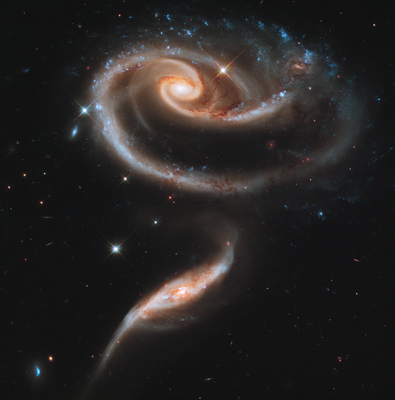
Contributed by: evilscientist
...would be useful someday. Well in all seriousness I did, but this made some of the theory a little less theoretical. My bi-monthly edition of SkyNews showed up shortly after the end of the postal strike with a beautiful Hubble shot of the interacting galaxies known as Arp 273 (click on the photo for the large version from the Hubble site). Looking at the photo, things look strangely familiar...A pretty pair of interacting galaxies for sure. From this shot I can tell you a couple of things, one the galaxy on the bottom was the intruder galaxy and has recently (within the past 250 million years or so) passed through the galaxy on top. This has caused much star creation (the blue areas) on one side of the top galaxy (showing that the bottom galaxy didn't pass exactly through the centre). I know the second because during galaxy collisions the actual stars don't collide, but it does cause disruption and compression of the gas in each galaxy, which in turn triggers stellar creation.
I know the first thing because during one of my courses I was able to play with use for serious astrophysical research the supercomputer at Swinburne to do, well, galaxy interactions. One thing I noted after running many simulations (and burning up several weeks of supercomputer time) was that you get some interesting looking results with galaxy interactions. For example I present the following interaction between two disk (spiral) galaxies of similar mass. The intruder comes in at a 45 degree angle and hits the target galaxy dead centre. If you notice at about 720 million years after the start of the simulation (shown at the top as 0.720 Gyr) the two simulated galaxies look a lot like ARP 273. (all three are of the same collision, just from different angles, the XY projection shows the shapes the best)
XY Plane
XZ Plane
YZ Plane
If the two galaxies were similar sized (not necessarily the case) and the intruder hit at a similar speed to the one in the simulation, these two galaxy may eventually merge together and form a large elliptical galaxy (in about 3 or so billion years from how we see them). To get a more accurate impression of their future a simulation would need to be run with the relative masses of these two galaxies which would, through trial and error, provide the original impact parameters (angle of impact, velocity) and then could be run forward to see what will happen. Isn't physics fun! Even so, the closeness of the simulation is amazing. All that learning wasn't for naught!
Evilness
http://www.evilscientist.ca/article.php?story=20110714201226406